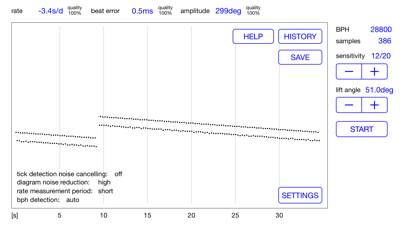
It should be obvious, but we’ll say it anyway: the Frederique Constant Analytics will not empower you with watchmaking skills, so opening your watch and fiddling with the movement for that extra bit of performance your analysis revealed is strongly advised against. The Frederique Constant Analytics, as we noted, shall support a wide range of frequencies, covering almost all mechanical watches available on the market and, in case the user doesn’t know the watch’s frequency, the frequency auto detect function of the app will help with that as well. We are planning on getting our hands on one of these devices soon to see how well it works and if it does, then put some watches to the test. This could be interesting to see how the performance changes over time as the mainspring unwinds and loses torque or, for the ultimate watch nerd-fest, check the same thing in a watch equipped with a remontoire constant force mechanism. Speaking of long-term thinking, the Frederique Constant Analytics can actually record and save a longer measurement like, say, 12 hours, to analyze the long-time performance of your watch.

The result is plotted in a chart, which can be saved for later reference. “Within seconds” – says the brand – the app measures the accuracy of the watch and an oscilloscope shows the audio waveform in real time.
#WATCH TIMEGRAPHER ANDROID ANDROID#
The way it works is that you place your watch in between the padded material-covered claws of the clamp, which you then connect to your iOS device (iPhone or iPad), or Android phone that is running Frederique Constant’s SwissConnect Analytics App. Frederique Constant promises the Analytics device to be accurate to at least +/- 0.2 seconds per day, which actually is quite good. That said, the Frederique Constant Analytics device, a little clamp that you attach to your watch, should work well on most traditional mechanical wrist- and pocket watches. This, mind you, also means that if your watch is fitted with a fancier, more unusual escapement, such as Omega’s Co-Axial escapement, chances are that the device will not be able to analyze its accuracy since unusual escapement layouts make different sounds that confuse the analytical software.

The Frederique Constant Analytics device actually works on pretty much the same principle as those much more expensive devices that watch makers use – such as the so-called Witschi machines – in that it is equipped with a microphone that records the tick-tock sound of a movement and analyses that audio to determine the rate and accuracy of the movement inside. Your best option thus far was to either try and match your watch’s time display to a reliable external reference time and keep track of how it faired over the course of a few days, or, for a more immediate and complex result – that would measure performance in different positions of the watch – you’d have to bring the watch to a better equipped watch repair store.

With the just announced Frederique Constant Analytics device, a small, easy to use, and relatively affordable watch accuracy measuring device, the promise is that checking your watch’s accuracy has gotten a whole lot easier and more convenient.ĭevices that can determine a mechanical watch movement’s accuracy have pretty much always been expensive and rather complicated, hence falling out of the reach of most watch enthusiasts ( see our recent review of the Lepsi Watch Analyzer, for instance). Learning more about the intricacies of a mechanical wrist watch’s accuracy – and especially that of one’s own timepiece – is an evergreen topic of discussion among us watch nerds.


 0 kommentar(er)
0 kommentar(er)
